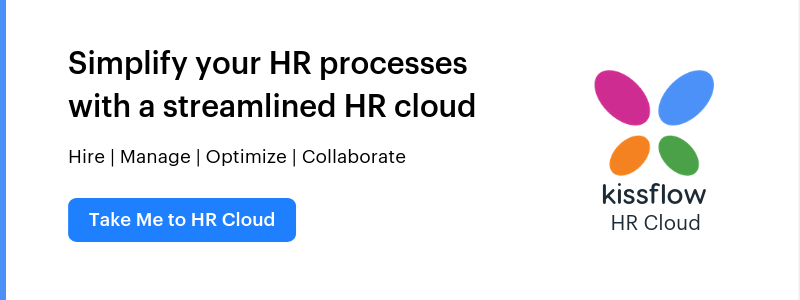
- >
- Human Resources >
- 5 Essential Features of an Effective Performance Appraisal System
5 Essential Features of an Effective Performance Appraisal System
Team Kissflow
Updated on 21 May 2025 • 5 min read
Successful businesses understand the value of investing in a robust performance appraisal system. That’s because they reap the benefits of employees who have regular and fruitful performance conversations with their line manager, understand their strengths and opportunities for improvement, and are more effective and motivated in their roles. The right performance appraisal tool can make this process simpler and more useful for everyone.
What is the purpose of a performance appraisal system?
A performance appraisal system manages the employee performance process of an organization to evaluate the job performance of a team. It includes capturing qualitative and quantitative feedback and turning them into actionable insights. These insights can improve the quality of the team and the output by setting and monitoring goals.
What’s the best way to structure a performance appraisal process?
It is essential to have a streamlined process in place before implementing a performance appraisal system. While the process may differ depending on the specific industry that organization is in, there are a few key elements that should be included in the form as standard.
Listed below are some of the major components that a standard performance appraisal process needs to have:
1. Employee self service
The major element of performance management is employee self evaluation. It enables employees to look back at their performance and take responsibility for their performance successes and improvement opportunities.
2. 360-degree appraisal
This step in the appraisal process focuses on gathering feedback on an employee’s performance from different stakeholders across the organization, and sometimes, from external individuals, and it can be streamlined using tools like an HR onboarding app that centralizes employee data and interactions, making it particularly effective when integrated with employee onboarding automation. This 360-degree feedback is usually made up of input from the line manager, peers, subordinates or direct reports (if applicable), clients, customers, or third-party partnerships. This offers a useful way to receive unbiased, specific, and well-rounded feedback on an employee’s performance from different perspectives.
3. Manager performance appraisal
This is the most important step in the performance appraisal process. It comprises of tasks like goal setting, progress tracking, quantitative employee rating, one-on-one discussions, and more.
4. Rewards and recognition program
In order to win the war for talent and retain top-performing employees, all organizations need to keep their employees motivated by celebrating their accomplishments. They also focus on making rewards unique, such as Custom Canvas Prints or giving employees paid holidays. Most top-performing organizations have made rewards and recognition an integral part of their talent management process.
5. Performance improvement plan
Keeping track of slipping performance and taking steps to remedy it is a crucial part of every employee performance process. Based on employee performance trends, organizations need to trigger a skill-specific performance improvement plan right after the evaluation phase, which can also be aligned with operational tools like employee expense management to ensure overall efficiency.

Chief Evangelist Digital TransformationKissflow
Getting Started With The Employee Performance Appraisal Template
Common misconceptions about performance appraisal software
For most organizations, implementing a brand new performance management system can be a daunting task. Failed implementation attempts in the past coupled with common misconceptions can make any organization nervous to implement a performance appraisal system.
Given below are some common misconceptions about performance appraisal software:
1. There is little to no return on investment
Reality: While it is hard to quantify the exact ROI of performance management software, businesses benefit in other ways like: improved efficiency, increased employee motivation, elimination of bias, and more.
2. Most performance appraisal systems come with a long learning curve
Reality: Some performance appraisal systems are more intuitive than others, so keep that in mind when you are searching.
3. We don’t need software, spreadsheets work just fine
Reality: Although spreadsheets and performance evaluation forms may work fine for small businesses, as an organization begins to grow they are not suitable to manage employee performance efficiently.
4. A performance appraisal system will magically fix all performance related issues
Reality: Unfortunately, this isn’t correct. Software albeit expensive or popular can’t do anything on its own. In order to get the most out of your appraisal software, you need to streamline your processes and choose a tool that is in tune with your HR strategy.
The top 5 features you should look for in a performance appraisal system
A good performance appraisal system software does a lot of good things for your organization. It lets you automate your performance appraisals and serves as a platform to receive continuous employee feedback by saving the time and effort of HR managers.
Here are some of the features you should be looking for when choosing your performance appraisal software.
1. Through performance reviews
Performance Management Software should let you set up and track goals, rate job performance, get insights into each employee’s performance.
2. Performance appraisals on the go
A good performance appraisal system lets you to conduct efficient performance reviews on the go. A cloud-based system lets you access the software anywhere you are and get work done.
3. Customizable as per your needs
A Performance appraisal system should let you streamline the performance management process as per your business requirements. Customize the workflow, configure multi-level appraisals, approvals and remainders.
4. Integrates with other HR tools
Instead of a standalone performance appraisal system, you should look for a system which lets you integrate with other HR apps like feedback, on-boarding, off-boarding, payrolls, etc.
5. Gathers 360 feedback
Get an in-depth evaluation of an employee’s engagement and performance by setting up team-wide or company-wide 360-degree feedback.
What are the main types of performance appraisal systems?
Since there are several variations of performance evaluation forms on the market, it’s essential to choose an appraisal software that is in tune with your business.
1. General appraisal
This performance appraisal system covers the main elements of traditional performance management. As part of this process, there is usually an annual performance meeting between management and team members to discuss performance and overall contribution towards the company’s success during the review period.
2. 360-degree appraisal
This type of performance appraisal system focuses on gathering feedback on an employee’s performance from different stakeholders across the organization, and sometimes, from external individuals. This is usually made up of input from the line manager, peers, subordinates or direct reports (if applicable), clients, customers, or third-party partnerships. This type of system can be a useful way to receive unbiased, specific, and well-rounded feedback on an employee’s performance from different perspectives.
3. Employee self-assessment
This is a performance appraisal system that is driven by the employees. Staff is central to the process, as they deliver an assessment of their performance, using evidence to back up their conclusions. While this system can be open to inconsistency, it can also be an excellent way for employees to take significant responsibility and accountability for their performance successes and improvement opportunities.
4. Manager performance appraisal (by objectives)
Key to this type of performance appraisal system is the set of specific goals that should be linked both to the employee’s job role and to your organization’s overarching business and HR strategy. The main elements of these systems are usually the setting of goals, subsequent progress, and achievement against said goals and employee scores or ratings, given by their manager.
5. Psychological appraisal
Businesses that use psychological appraisals have a much stronger focus on an employee’s potential for the future than on their past performance. A talent management process is usually at the heart of this type of performance management system. It aims to identify individuals with skills and attributes that could contribute to future business success and reward and provide promotional opportunities accordingly.
Automating your performance appraisal system using Kissflow HR Cloud
A performance appraisal system is not a stack of just talent related processes—goal setting, feedback, and rating. It needs to be a closed-loop process that integrates seamlessly with other talent management aspects like training, rewards and recognition, benefits management, and more.
Kissflow HR Cloud will not only vertically align all HR processes with performance management but also ensures that these HR processes play well with each other. Being an all-in-one HR software, it meets the performance needs of organizations of all sizes. It enables businesses to align individual employees and teams with corporate goals and strategies efficiently.
Its qualitative employee performance review process sets clear direction and focus for employees. With Kissflow HR Cloud, organizations can conduct fair and bias-free appraisals that capture the 360-degree view of an employee’s performance accurately. Best of all, it automatically triggers a performance improvement plan when an employee’s performance slips below a specific level.
Conclusion
An organization’s performance appraisal method is often unique to its culture. Therefore, choosing a system that plays well with other HR processes can be a challenge. However, saving time and valuable resources by investing in a suitable performance appraisal system for your business is undoubtedly worth the challenge. Get started with the Kissflow Platform and learn how to leverage its features to drive better results
Choosing an integrated HR suite like Kissflow HR Cloud provides clarity, direction, support, and recognition to both employees and the organization. It aligns an organization’s talent strategies towards a unified business goal while ensuring employee happiness.
Sign up for a free trial of Kissflow HR Cloud and create a performance-driven culture.
Related Articles


.webp?width=285&height=570&name=Kissflow-HR-Platform%20(1).webp)

![Performance Management: The Handbook to HR [Best Practices 2021]](https://kissflow.com/hs-fs/hubfs/Kissflow-HR-Cloud-4.webp?width=352&name=Kissflow-HR-Cloud-4.webp)









